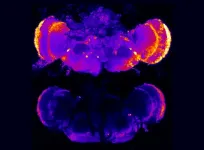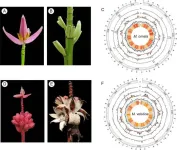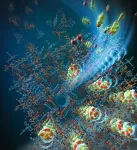(Press-News.org) UNIVERSITY PARK, Pa. — A class of proteins that regulates cell repair and enhances cell growth-signaling systems could be a promising new target for the treatment of Alzheimer's and other neurodegenerative diseases, according to a new study led by researchers at Penn State. They found that disrupting necessary sugar modifications of these proteins promotes cell repair and reverses cellular abnormalities that occur in neurodegenerative diseases.
The study appeared today (July 2) in the journal iScience, and the researchers have a patent related to this work.
“Strategies to treat Alzheimer's disease to date have largely focused on pathological changes prominent in the late stages of the disease,” said Scott Selleck, professor of biochemistry and molecular biology in the Penn State Eberly College of Science and leader of the research team. “Although recently [U.S. Food and Drug Administration]-approved drugs have shown the ability to modestly slow the disease by targeting one of these changes, amyloid accumulation, drugs that affect the earliest cellular deficits might provide important tools to stop or reverse the disease process. We are interested in understanding the earliest cellular changes that are found not only in Alzheimer's, but shared across other neurodegenerative diseases, including Parkinson's and amyotrophic lateral sclerosis (ALS).”
Roughly 6.9 million Americans over the age of 65 are estimated to be living with Alzheimer’s disease, according to the Alzheimer’s Association. Despite its widespread impact, there is no agreed upon biological cause or mechanism for the disease. Cell-signaling molecules called heparan sulfate–modified proteins have been implicated in the development of Alzheimer’s, but their specific role has remained unclear, Selleck said. In this study, the research team first performed a series of analyses in human cell lines and mouse brain cells that express aspects of Alzheimer’s, showing that these proteins regulate cellular processes known to be affected in several neurodegenerative diseases.
Heparan sulfate–modified proteins are found both on the surface of animal cells and in the matrix between cells. This class of proteins are named for a sugar polymer that bears many sulfate groups, called heparan sulfate. Heparan sulfate chains are attached to specific proteins, and this modification allows these proteins to assemble signaling complexes that affect cell growth and influence how the cell interacts with its environment. These signaling pathways also regulate autophagy, a process of cell repair that clears out damaged or dysfunctional components in the cell.
“In the early stages of several neurodegenerative diseases, autophagy is compromised, which means cells have a reduced repair capacity,” Selleck said. “In this study, we determined that heparan sulfate-modified proteins suppress autophagy-dependent cell repair. What’s more, we show that by compromising the structure and function of the sugar modifications of these proteins, the levels of autophagy increase so cells can take care of damage.”
The researchers found that, in human and mouse cells, reducing the function of heparan sulfate-modified proteins also rescued other pathologies that arise early in neurodegenerative diseases, improving the function of mitochondria — which are responsible for energy production in the cell — and reducing build-up of lipids, or fatty compounds, inside cells.
The researchers then evaluated the role of heparan sulfate-modified proteins in an animal model of Alzheimer's, a fruit fly with deficits in a presenilin protein. Presenilin mutations cause early onset disease in humans and likewise in fruit flies; defective presenilin causes cell death and brain degeneration. In flies with deficits in presenilin, reducing the function of heparan sulfate chains suppressed the death of neurons and corrected other cell defects as well. These results are directly relevant to recent human genetics research, the researchers said.
“Individuals with mutations in a presenilin gene, PSEN1, develop Alzheimer's in their mid-40s. But if they also inherit a rare genetic change in a specific protein called APOE, the disease is delayed, sometimes by decades,” Selleck said, explaining that APOE plays an important role in lipid transport and binds to heparan sulfate. “This change in APOE — which has been in the news lately — greatly reduces APOE binding to heparan sulfate. Our work builds on and extends these findings, directly implicating heparan sulfate in Alzheimer’s pathology involving both PSEN1 and APOE. Targeting the enzymes that make heparan sulfate could provide a means of blocking neurodegeneration in humans.”
Collectively, these results show that disrupting the structure of heparan sulfate modifications, blocks or reverses early cellular problems in these models of Alzheimer's.
“We save the animal from neuron cell loss, mitochondrial defects and rescue behavior deficits that serve as a measure of nervous system function,” Selleck said. “These findings suggest a promising target for future treatments that could rescue the earliest abnormalities that occur in many neurodegenerative diseases.”
The researchers also explored how gene expression changed when they eliminated the capacity of human cells to make heparan sulfate chains. They found that expression levels of more than 50% of approximately 70 genes known to be associated with late-onset Alzheimer's disease were modulated, including APOE, suggesting a link between heparan sulfate-modified proteins and the more common and late onset forms of Alzheimer’s disease.
“There is a critical need to focus on cellular changes that occur at the earliest times in disease progression and develop treatments that block or reverse them,” Selleck said. “We demonstrate that reduced autophagy, mitochondrial defects and lipid build-up — all common changes in neurodegenerative disease — can be blocked by altering one class of proteins, those with heparan sulfate modifications. We think these molecules are promising targets for drug development.”
The researchers suspect that disrupting this pathway to promote cell repair systems could be important for a wide variety of other diseases where autophagy defects occur.
“The applications of manipulating this pathway may be broadly useful across a number of human medical conditions,” Selleck said.
The research team at Penn State also includes co-authors Nicholas Schultheis, doctoral student in the Biochemistry, Microbiology and Molecular Biology program; Alyssa Connell, research assistant; and Richard Mueller, Alexander Kapral, Robert Becker, Shalini Shah, Mackenzie O’Donnell, Matthew Roseman, Lindsey Swanson and Sophia DeGuara, all undergraduate students. Contributions were also made by researcher Weihua Wang and Associate Professor of Pharmacology Fei Yin at the University of Arizona and graduate student Tripti Saini and Assistant Professor of Biochemistry and Molecular Biology Ryan Weiss at the University of Georgia.
Funding from the National Institutes of Health and the Penn State Eberly College of Science supported this research.
END
Potential new target for early treatment of Alzheimer's disease
Disrupting a class of sugar-modified proteins improves cell repair, rescues neuron loss and reverses cellular changes associated with neurodegenerative diseases, researchers report
2024-07-02
ELSE PRESS RELEASES FROM THIS DATE:
Subnormal serum liver enzyme levels
2024-07-02
Liver diseases are commonly diagnosed using serum enzyme assays, particularly for aspartate aminotransferase (AST), alanine aminotransferase (ALT), alkaline phosphatase (ALP), gamma-glutamyl transpeptidase (GGT), and 5'-nucleotidase (5'-NT). While elevated levels of these enzymes are typically associated with liver and bile duct injuries, subnormal levels can also indicate various pathologies. This review consolidates current knowledge on diseases linked with subnormal liver enzyme levels, focusing on their pathogenesis, specificity, and treatment ...
Too much treadmill? This could help your shin splints
2024-07-02
Good news for all the treadmill runners who suffer from stubborn and painful shin splints: A little outdoor gait training may help, new research suggests.
A randomized controlled trial found that four weeks of gait training outdoors, in addition to home exercises often prescribed for shin splints, led to improved running biomechanics even when the runners were using a treadmill. These improvements included decreasing the time the runners’ feet were in contact with the ground or treadmill, a recently identified contributor to shin splints.
Based on the trial results, ...
Journal of Participatory Medicine announces new theme issue on Patient and Consumer Use of Artificial Intelligence for Health
2024-07-02
(Toronto, July 2, 2024) JMIR Publications invites submissions to a new theme issue titled “Patient and Consumer Use of Artificial Intelligence for Health” in its premier open access journal Journal of Participatory Medicine indexed in PubMed, SCOPUS, Sherpa Romeo, and DOAJ.
This theme issue will explore the use of AI for health (AIH) from the perspectives of patients and the public. The journal is seeking papers that examine (a) the experience and impact of patients and health consumers using AI applications, and (b) the involvement of patients, caregivers, and the public in the co-design and development of AIH.
For this theme issue, the journal ...
Unveiling the genetic secrets of Musa ornata and Musa velutina: insights into pericarp dehiscence and anthocyanin biosynthesis
2024-07-02
In a pioneering study, researchers have completed the chromosome-level genome assemblies for Musa ornata and Musa velutina, shedding light on the genetic underpinnings of pericarp dehiscence and anthocyanin biosynthesis in bananas. This genetic blueprint is poised to revolutionize the enhancement of bananas' ornamental appeal and nutritional quality, unlocking mysteries that were previously obscured by limited genomic data.
Musa ornata and Musa velutina, known for their ornamental appeal, face cultivation challenges ...
Researchers achieve dual-functional supramolecular materials
2024-07-02
Versatile molecular frameworks called discrete supramolecular structures act like microscopic building blocks customizable for a wide variety of applications. The structures can serve in drug delivery, provide unique environments for catalytic reactions or plug into a molecular machine.
In their paper published June 25 in the Journal of the American Chemical Society, researchers from Yokohama National University presented a new methodology to advance self-assembly of dual-functional supramolecular materials.
Self-assembly involves the spontaneous generation of a well-defined, discrete supramolecular architecture from ...
A new target for treatment of one type of macular degeneration
2024-07-02
COLUMBUS, Ohio – A new study in mice hints at the promise of an eventual alternative treatment option for the “wet” version of age-related macular degeneration (AMD).
Researchers determined in mice that an enzyme related to cell growth and division is a culprit in the blood vessel invasion in the back of the eye that causes blurred central vision in wet AMD. Targeting the enzyme, called telomerase, with an experimental drug suppressed abnormal vascular growth in the animals’ retina.
The only current treatment for wet AMD is injection into the eye of a medication that blocks the activity of a growth factor protein, called VEGF, which is ...
Australian bushfire ash is deadly for aquatic life
2024-07-02
While the impact of wildfires on terrestrial life has been well studied, only recently has research started to examine the effects of wildfire ash on aquatic organisms. New research reveals that wildfire ash can have lethal consequences on Australian water ecosystems.
Wildfires are becoming more prevalent due to the warming and drying effects of climate change, with Australia becoming especially vulnerable to dangerous bushfires. “Therefore, many Australian species may be threatened by fires,” says Miss Jenelle McCuaig, a Masters student at the University ...
Starfish skeleton inspires new 4D morphing structure
2024-07-02
Researchers have recently developed a flexible-yet-sturdy morphing structure inspired by the starfish skeleton that exhibits 4D morphing features with promising applications for robotics, aviation, and medical devices.
“Starfish possess the remarkable ability to effortlessly hold themselves in any body posture by changing the stiffness of their endoskeleton,” says Raman, a PhD student in the Biological Structures and Biomimetics workgroup at Hochschule Bremen - City University of Applied Sciences Bremen, Germany.
Ossicles are calcite microstructures inside starfish bodies that are connected in a ...
Eating more soy foods could improve thinking and attention in kids
2024-07-02
Chicago (July 2, 2024) — A new study found that school-aged children who consumed more isoflavones from soy foods exhibited better thinking abilities and attention. These findings pave the way for future research aimed at unraveling how soy foods can positively impact children's cognitive abilities.
Isoflavones are naturally occurring compounds found in various plants, particularly soybeans and soy products. Although previous research in adults has suggested that soy isoflavones can improve memory, the ...
Changes in emergency contraceptive fills after Massachusetts’ statewide standing order
2024-07-02
About The Study: The Massachusetts statewide standing order policy was associated with a 32% increase in emergency contraceptive fills at pharmacies versus comparison states. After the policy, fills for prescription-only ulipristal more than doubled and accounted for the observed increases in fills for emergency contraceptives.
Corresponding Author: To contact the corresponding author, Dima M. Qato, Pharm.D., M.P.H., Ph.D., email qato@usc.edu.
To access the embargoed study: Visit our For The Media website at this link https://media.jamanetwork.com/
(doi:10.1001/jama.2024.11715)
Editor’s ...
LAST 30 PRESS RELEASES:
Heart-brain connection: international study reveals the role of the vagus nerve in keeping the heart young
Researchers identify Rb1 as a predictive biomarker for a new therapeutic strategy in some breast cancers
Survey reveals ethical gaps slowing AI adoption in pediatric surgery
Stimulant ADHD medications work differently than thought
AI overestimates how smart people are, according to HSE economists
HSE researchers create genome-wide map of quadruplexes
Scientists boost cell "powerhouses" to burn more calories
Automatic label checking: The missing step in making reliable medical AI
Low daily alcohol intake linked to 50% heightened mouth cancer risk in India
American Meteorological Society announces Rick Spinrad as 2026 President-Elect
Biomass-based carbon capture spotlighted in newly released global climate webinar recording
Illuminating invisible nano pollutants: advanced bioimaging tracks the full journey of emerging nanoscale contaminants in living systems
How does age affect recovery from spinal cord injury?
Novel AI tool offers prognosis for patients with head and neck cancer
Fathers’ microplastic exposure tied to their children’s metabolic problems
Research validates laboratory model for studying high-grade serous ovarian cancer
SIR 2026 delivers transformative breakthroughs in minimally invasive medicine to improve patient care
Stem Cell Reports most downloaded papers of 2025 highlight the breadth and impact of stem cell research
Oxford-led study estimates NHS spends around 3% of its primary and secondary care budget on the health impacts of heat and cold in England
A researcher’s long quest leads to a smart composite breakthrough
Urban wild bees act as “microbial sensors” of city health.
New study finds where you live affects recovery after a hip fracture
Forecasting the impact of fully automated vehicle adoption on US road traffic injuries
Alcohol-related hospitalizations from 2016 to 2022
Semaglutide and hospitalizations in patients with obesity and established cardiovascular disease
Researchers ‘listen in’ to embryo-mother interactions during implantation using a culture system replicating the womb lining
How changing your diet could help save the world
How to make AI truly scalable and reliable for real-time traffic assignment?
Beyond fragmented markets: A new framework for efficient and stable ride-pooling
Can shape priors make road perception more reliable for autonomous driving?
[Press-News.org] Potential new target for early treatment of Alzheimer's diseaseDisrupting a class of sugar-modified proteins improves cell repair, rescues neuron loss and reverses cellular changes associated with neurodegenerative diseases, researchers report






